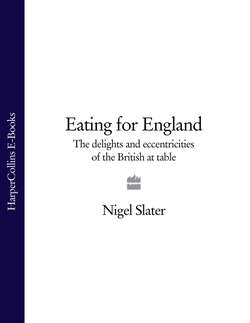Читать книгу Eating for England: The Delights and Eccentricities of the British at Table - Nigel Slater - Страница 31
Custard
ОглавлениеIt is difficult not to think of custard with affection. Though it must be said that to the British it is more likely to be vivid yellow and made with custard powder than the calm and pallid crème anglaise favoured by the French. Now even that shortcut has been superseded by ready-made versions available at the chilled counter, some of which are almost indistinguishable from a handmade egg custard sauce.
The point of custard, or more correctly custard sauce, is essentially to help a dry pudding – treacle tart or spotted dick, say – down the gullet, but it is also a pudding in itself, especially when it becomes the divine dessert banana custard. (I have always found watching slices of banana sink slowly into a deep Pyrex bowl of custard particularly agreeable.) Made somewhat thicker, it is firm enough to be used as a layer, along with sponge cake, fruit and cream, in a trifle.
Yet nowhere is it as welcome as with a steamed sponge. Ginger, jam or raisin puddings are rarely quite themselves without a steaming moat of custard, although somehow treacle pudding is better with cream. The main reason we turned to custard powder was not because of the cost of eggs, milk and vanilla, but because of the sauce’s reputation for curdling. ‘Curdle’, like ‘separate’, ‘split’ and ‘collapse’, is a word that brings unreasonable fear to the hearts of many British cooks. The truth is that nothing can go wrong if you keep the mixture from getting too hot, and even then a curdled mess can sometimes be rescued with a good stiff beating in a cold bowl with a wire whisk.
